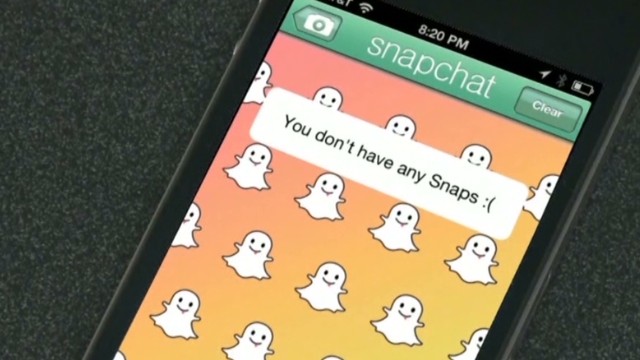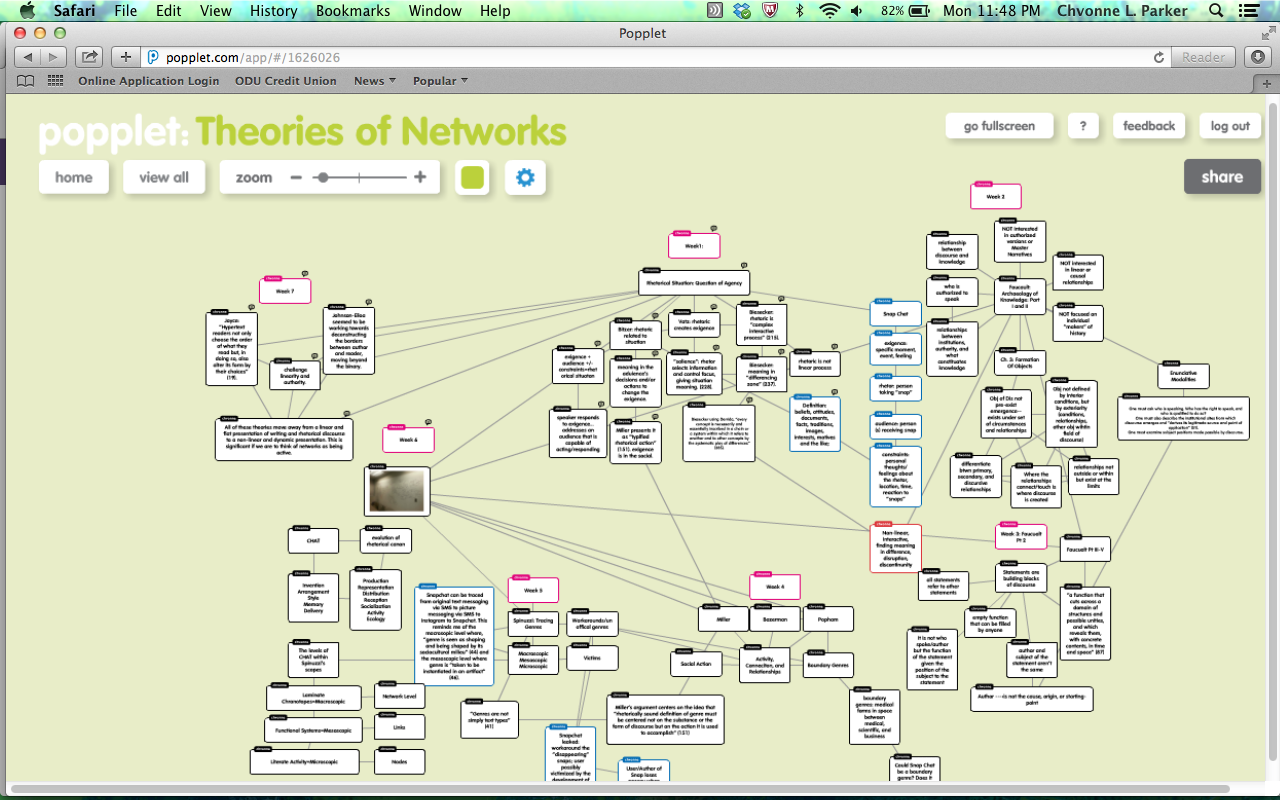Theories
Which 2 – 4 theories are you choosing and why?
Rhetorical Situation Theory: Bitzer, Vatz, and Biesecker provided different approaches to the rhetorical situation, which allow me to consider exigence (problem that invites a response), the rhetor, and the site of communication, respectively. If I utilize my re-proposed Oos, in which I expanded the Snapchat network to include the designers and the technology (infrastructure as well as the device), the above theorists will allow me to discuss Snapchat’s design creation as a part of the network because the creators are still creating the application. There are updates and changes to the device, which impact the Snapchat network. This theory will allow me to examine the users exchanges as rhetorical activity.
CHAT : Whereas rhetorical situation theory focuses on rhetorical activity of author, audience, text, and to some extent the situation, itself, CHAT focuses on literate activity. I think it is important to see the network as literate activity. In using CHAT I can expand from the rhetorical situation to the rhetorical canon, examining delivery, production, representation, and reception. I think using this theory will also help me to expand the original case study to address the cultural historical aspect of Snapchat. If Snapchat is situated within a cultural historical context, I would be able to address the design aspect of Snapchat as being part of the network. As mentioned before, the creators of Snapchat are still actively involved in and impact the network. It would be disservice to not include them in the network.
ANT: I am still undecided about using ANT. I feel that it is necessary because ANT flattens the network, which I feel is important. ANT also provides an easy way to include the technology in the network. Because all parts of the network are seen as actors, I can explain the role of technology in Snapchat. It is important to include this, as it is the application’s hiding of the snaps that makes it so significant. The ephemeral nature of Snapchat is easily discussed through ANT because ANT allows for the tracing of connections. There is a historical element to ANT that I did not address in my first case study. Returning to ANT (in conjunction with CHAT) may allow me to address this part of theory in a productive manner.
Affordances: The last theory that I am considering is JJ Gibson’s Theory of Affordances. This was my favorite theory of the semester because I felt it was the most accessible. This theory allows me to focus on action and perception, which I think is important for discussing Snapchat’s users and their interaction with the software. It also allows for the inclusion of the technology in the network. Through this theory, I am able to include the camera phone and multimedia messaging (MMS) into the Snapchat network. Camera phones and photo messaging are essential parts needed for Snapchat to function. Because I view Snapchat as a photo messaging application designed for mobile phones (smartphones, specifically) framed as a social network, affordances allows me to include the hardware and software as part of the network. Just as the aforementioned theories allowed me to expand beyond the users, affordances allows me to expand the environment of the network beyond the application of Snapchat to the smartphone (and possibly to the ISP network).
How are they similar enough that you can justify getting them to work together?
I would argue that the main similarity among these theories is activity. Rhetorical Situation theorizes the way rhetoric is created and the constituents required for this creation. CHAT and ANT both focus on activity. CHAT continues the work of the rhetorical situation theory, theorizing the production and overall movement of literate activity(rhetoric). ANT adds to this by focusing on the activity at all levels the network. Each part of the network is apart of the literate activity. ANT speaks more to action and the results of those actions. The theory of affordances also speaks to action and the results of actions. Affordances looks to what is in the environment, the purpose it serves, and the action allowed by the objects (and the allowable perceived by the users). Although each theory is different, they all focus on some aspect of activity, looking at the context required for activity to the movement of the activity.
How do they fill each other’s gaps?
In regards to filling the gaps, CHAT (ANT) allow for singular focus on literate activity. However, Affordances, CHAT, and ANT provide a lens through which to examine the way Snapchat functions. The rhetorical situation theory does not allow for such an examination. Also, CHAT, ANT, and rhetorical situation theory (particularly, Biesecker) address historical and social context. Affordances does not address historical context. However, affordances by way of Norman does address cultural conventions.
Scholar(ship)
How do these theories align with how you position yourself as a scholar?
This is a difficult question to answer because at this point in my education, I do not feel I have a position. I have not written, read, or thought about scholarship enough to have a position. I honestly feel at this point that I read and complete assignments to the best of my ability. Much of my research comes from class assignments. The closest I can get to positioning myself as a scholar would be my blog title: Academic Cypher. I wholeheartedly believe in the power of the Cypher. Rooted in African tradition of communicating and sharing spirit and knowledge in a circle, the cypher is a significant part of hip hop and the way in which I believe all knowledge can be created and transferred. My blog description states: “In hip hop culture, the cypher is a circle of MCs, B-boys/B-girls, beatboxers, etc who freestyle and/or battle one after the other without interruption, exchanging rhymes and flows back and forth or around. The cypher is where training takes place and skills are tested, where people collaborate, and where people create “off the top” or written/choreographed, tapping into the place where thought and action come together to share energy and advance the craft…the Academy should aim to do the same.” Knowledge exists within each individual and is connected by (and within) the cypher. The cypher is a network (I think I wrote myself into understanding this). Although this may be outside of the academy’s purview, I position myself as a member the cypher. I bring to the table what I have and throw it into the ring. I perform my conceptualization of the theory inspired by and connected to those who have performed before and perform with me. Ultimately, I hope to keep the cypher going (don’t break the chain), so that the exchange and creation never stops. The aforementioned theories align with this perspective in that they all consider the social, cultural, and historical aspects of production and reception.
How do these theories align with your own biases and background (the reason you came to this project in the first place)?
My thoughts on this question are similar to the previous question. I do not believe or see that I have a background on which to align anything. I am sure I have biases, but I do not know what they are. I chose the theories based on what I was able to understand. I did not choose the theories that I couldn’t understand. I came to Snapchat because I was interested in the move away from traditional social networking of creating a profile and archiving photos, experiences, and thoughts. Snapchat does not fit within my larger research focus which is bringing together rhetoric and hip hop. I greatly offends me that mainstream society does not see any value in hip hop beyond appropriation, commercialization, and commodification. It could be argued that they perceived the value, which lead to all those things. I chose to pursue an advance degree to be a walking contradiction. What I mean is that I wanted to show people (particularly African Americans) that one doesn’t have to choose between hip hop culture and mainstream society. They are not mutually exclusive. One can hit the streets and the books. This perspective may be why I am somewhat adverse to scholarship. Scholarship is for those within the academy. My audience (imagined/dreamed) are those outside of the academy. I think my bias is that I am anti-scholarship.
I guess my ability and level of understanding plays a significant part in the theories I choose. I saw Snapchat as a unique opportunity to examine a shift in social networking, as it is happening. Rhetorical Situation Theory, CHAT, ANT, and affordances allowed me to enter into an unfamiliar conversation because I recognized in each of them elements of rhetoric, which is familiar to me. I know the rhetorical situation, I know the rhetorical canon (CHAT). I previously read about ANT in Digital Humanities, so I was aware of the basics of the theory. I appreciated its focuses on activity and action. I also liked that it included everything as part of the network. It was not user or human centric, which I appreciate because everything (animate or inanimate) is impacted by everything else. Affordances was very new to me, but the theory was straightforward. It’s accessibility is what lead me to use if for Case Study #3. I liked the idea of perception impacts how we use things. I am sure that there is more to this than what I have presented. However, I am unable to articulate whatever that may be.


